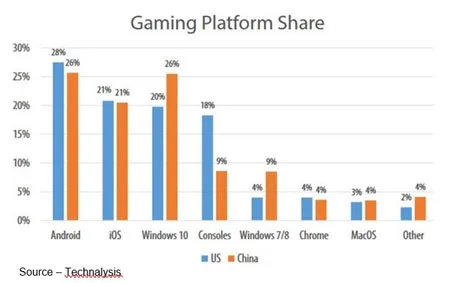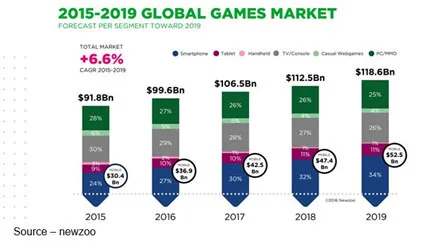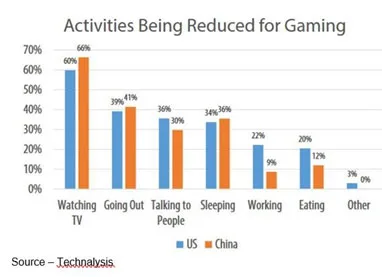Gaming Lets You Be Who You Want to Be

Our daughter was disappointed when Game of Thrones came to a close – didn’t like the way it ended and was disappointed there wasn’t going to be a season nine.
But according to Comic-Con previews, she does have Paramount’s Terminator: Dark Fate and Netflix’ The Witcher to look forward to late this year.
Until then, she’s back to being a sneaky, aggressive, give-no-quarter gamer.

Actually, games are a major pastime for most folks, young or old, according to Pew Research. Their activity accounts for an estimated 25 percent of the streaming activity on the Internet–even though it’s not as “glamorous” as watching OTT movies or binging on a TV series.
Online, on-device game play is almost universal – young/old, male/female – regardless of race, religion, sexual orientation, nationality. And even though guys like to brag about it, gals are as active and they’re as good as, if not better than, their male counterparts.
Like OTT viewing, a quarter of teens say they spend too much time playing on their screens.
Sure, casual; card; puzzle and strategy games are fine for wasting time on their phones; but when you crave a little action, nothing beats a good console or computer role-playing action/adventure, battle royale or shoot-em-up.
And when they have a real need to test their skills, nothing beats a solid MMO (massive multiplayer online) timewaster.
Like Most Gen Zers, she’s semi-platform agnostic – iPhone, Mac, Nvidia-powered PC system.
Thanks to Mark Poppin’s review at BTR (BabelTechReviews), she “had to have” a new GPU card for her PC because of her two new fave VR games – Beat Saber and Skyrim VR.
She used the daughter-to-dad logic, pouted and said, “But Dad, it will be a good investment– especially when I ‘get into’ Fallout 4 VR.
We’re personally not that into post-apocalyptic movies or games but the VR content is a great escape from all the garbage going on in our real world.
Since OTT – music, movies, TV – is an integral part of her entertainment, she got excited about Google (Stadia), Apple (Arcade), Amazon (????), Verizon (Gaming) and Microsoft (Project XCloud) getting into the streaming gaming service.

Imagine the exciting titles she could play anytime, anywhere and on any screen.
The poor deluded girl seriously thinks they care about her gaming experience and convenience, rather than preserving their subscription base, revenue stream.
We won’t bother showing her Bob O’Donnell’s (Technalysis president) new report on the global gaming market because suddenly she’ll find out that:
- None will be available until the end of the year
- Multi-device game play only means their interpretations of multi-devices – Android, Windows, Apple, game system
- Building a game is more difficult than shooting a bunch of content, editing it, adding audio and the rest of the post work
- Making it work the same way on every operating system is still just … a goal

That shot down Apple Arcade from her serious subscription list (even when it’s available) because even though she likes the company’s commitment to the privacy of her data, it’s really about the game play.
While she spends most of her time with her iPhone, as do most folks in her age group and younger, most of the mobile game options were more graphically elegant than conquer or be conquered, win big or lose challenging.
Her mobile play preference was similar to O’Donnell’s global findings.

When it comes to mobile game play, people focus less on the more “involved” games and fill time with role playing, casual, puzzle, strategy activities.
Actually, game play may just be the application smartphone producers have been looking for to rejuvenate the sale of devices which has ground to an embarrassing slosh because high-performance smartphone sales have sllloooowwwweeeedddd.

There are several reasons games could be the boost these folks need to sell newer, more powerful (more expensive) devices:
- Gaming on any device requires high-end, powerful graphics processing capability + CPU performance
- High-end smartphones use the latest high-end chips
- Gaming phones are overclocked and have special cooling solutions
- High-end games (not card games, Candy Crush, Angry Birds, etc.) like Fortnite and Tencent’s Honor of Kings already have huge user bases, especially in APAC
With almost 600 M gamers in China and about 50 percent of the $140B gaming market growing at 13 percent per year, it looks like an audience waiting for a solution.
Even a little improvement (15 percent) in graphics performance as well as improved resolution/frame rates and gamers will live with 4G bandwidth performance until 5G/Wi-Fi 6 is available over the next two years.
By that time, the streaming gaming experience could be “almost” as good as PC gameplay.
China currently leads smartphone gaming operators in the Americas; and in EU, they are projecting a major increase. That could benefit everyone – game developers, device producers and wireless service providers.

The ESA (Entertainment Software Association) found that 60 percent of gamers play on their smartphones worth more than $52B.
And it could be even more profitable for all of the participants.
For example, Fortnite already has a huge user base with its “battle royal” mode enjoyed by millions of fans.
Created by Epic Games (backed by China’s Tencent) it can support 100 players who battle one another for weapons and armor until only one player is left.
Being able to play on anything from a souped-up smartphone to a tricked-out PC will be huge for players, including our Gen Zer.
Free-to-play Fortnite makes its money from in-app purchases when players use real-world money to buy character outfits, gear, scoring celebrations and more (lots more).
In the heat and adrenalin rush of battle, it’s pretty easy to spend $10 – $20 a month for in-game purchase items, which may be why SuperData estimates they raked in $2.4B last year.
Epic isn’t alone in seeing the cross-device game play/revenue arena.
Electronic Arts’ Apex Legends reported 50M players worldwide in its first four weeks (all platforms) and Activision Blizzard is busy with Tencent for a mobile version of Call of Duty.
But when it comes to real game play – hard core, heart pounding, sweaty-palmed action/adventure, shoot-em ups, battle royale and multiplayer online battle arena (MOBA) – she and other gamers have to make tradeoffs.
 According to O’Donnell, they cut back on watching OTT streaming content, going out (it’s a little tough lugging around a hard-core gaming system, even a serious gaming notebook). And obviously, talking with friends and the rest of the family is restricted.
According to O’Donnell, they cut back on watching OTT streaming content, going out (it’s a little tough lugging around a hard-core gaming system, even a serious gaming notebook). And obviously, talking with friends and the rest of the family is restricted.
While folks still prefer to play on their computer (it has a lot more GPU power, so images/action are real), gaming is a lot like OTT streaming … whatever screen you have in your hand or you’re in front of, game on!
Of course, her mother isn’t happy about our Gen Zer playing some of the more violent games; but we’re rather glad she’s out there fighting aliens from other planets and taking out the hordes of zombies that just never seem to want to stay down.
Pew Research said people had a common concern that violent games drive real-time aggression but studies by the APA (American Psychiatric Association), Oxford Internet Institute and other organizations find no link between the degree of violence and real-world aggression.
Although we’re not a huge gamer (O.K., we’re pathetic at it), we agree with most sociological/psychological research that explains game play as a way to release the frustrations of the day, achieve your ideal self – braver, faster, fairer, more generous, more glorious than you might actually be – or simply be the best you can be.
Self-actualization is at the top of Maslow’s hierarchy of needs (https://tinyurl.com/c4y67hb), which is probably why game play on any device not only continues to be popular but is also a helluva’ lot better for you than some of the stuff you do.
Or, as Richard Bartle, an early MMO developer, noted; “Basically, if you’re a jerk in real life, you’re going to be a jerk in any kind of social setting, and if you’re not, you’re not.”
There are a lot of reasons for playing games seriously and casually, which is why O’Donnell found people are continuing to spend more time and money gaming on any/every platform/device.
As Confucius said, “wherever you go there you are.”
To which Parzival added, “It’s not about winning, it’s about playing.”
# # #
Andy Marken – [email protected] – is an author of more than 700 articles on management, marketing, communications, industry trends in media & entertainment, consumer electronics, software and applications. Internationally recognized marketing/communications consultant with a broad range of technical and industry expertise especially in storage, storage management and film/video production fields. Extended range of relationships with business, industry trade press, online media and industry analysts/consultants.